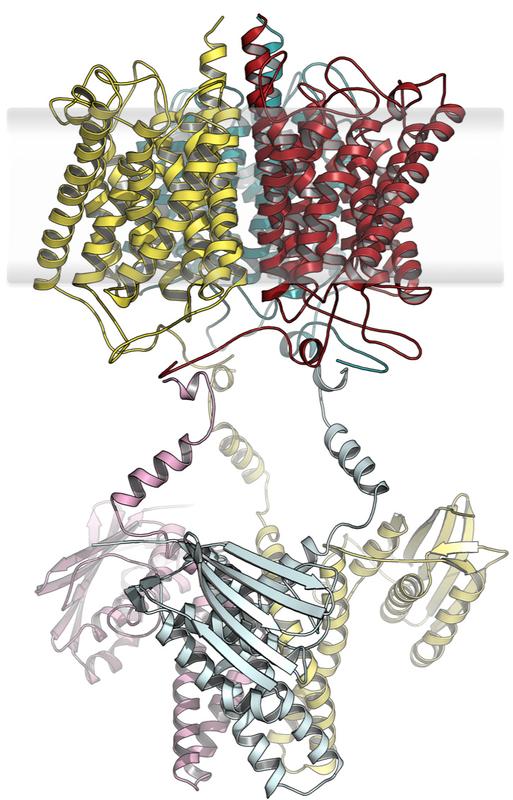Microbial signal recognition stems from existing building blocks

Hypothetical extended model of the anammox ammonium sensor protein. Source: Susana Andrade
A team led by the Freiburg biochemist Prof. Dr. Susana Andrade has characterized a protein that enables certain microorganisms to recognize and absorb ammonium in their environment. Ammonium is considered a toxin that pollutes ecosystems – but for these bacteria it represents an important nutrient and energy source. The researchers have published their findings in the scientific journal Nature Communications.
The element nitrogen is an indispensable building block of all biomolecules and therefore of great importance to all organisms. In addition, some members of the microbial community have specialized in using various nitrogen compounds as energy source for optimal growth. This is especially the case amongst anaerobic ammonium oxidizers:
These bacteria do not require oxygen for their metabolism but instead, convert two important nitrogen compounds, ammonium and nitrite, into nitrogen gas, which accounts for about 80 percent of the earth's atmosphere. Through this reaction, these microorganisms play an important role in the detoxification of nitrogen compounds that are increasingly released into the environment through the use of fertilizers.
Andrade and her team from the Faculty of Chemistry and Pharmacy at the University of Freiburg have identified an unusual protein in such bacteria: Half of it resembles known transport proteins for ammonium ions and the other half belongs to a group of signal transducing proteins.
This led to the suspicion that two building blocks, already existing in nature, had been combined in a modular way to enable a completely new functionality: the detection of ammonium from the environment and subsequent transmission of this information to the cellular signaling networks.
The researchers undertook a comprehensive functional and structural characterization of this novel protein, which also involved working groups from the University Medical Center Freiburg; Radboud University in Nijmegen, The Netherlands; the Russian Academy of Sciences; and the European Molecular Biology Laboratory (EMBL) in Hamburg. As a result, the original assumption was confirmed:
Based on a highly selective ammonium transport protein, evolution has given rise to a new recognition site for the ions, whose occupation leads to conformational changes that are passed on to the signal transducing module. This direct modular coupling offers the prospect of fusing other signal transduction units to the ammonium sensor module to engineer new cellular functionalities.
Susana Andrade heads the molecular biophysics research group at the Institute of Biochemistry, Faculty of Chemistry and Pharmacy at the University of Freiburg and is an associate member of the Freiburg Excellence Cluster BIOSS – Center for Biological Signalling Studies. Dr. Tobias Pflüger, the first author on the publication, has recently completed his PhD in the Andrade working group.
Original publication:
Tobias Pflüger, Camila Hernández, Philipp Lewe, Fabian Frank, Haydyn Mertens, Dmitri Svergun, Manfred W. Baumstark, Vladimir Y. Lunin, Mike S.M. Jetten & Susana L.A. Andrade. 2018. Signaling Ammonium across Membranes through an Ammonium Sensor Histidine Kinase. In: Nature Communications, DOI: 10.1038/s41467-017-02637-3.
Contact:
Prof. Dr. Susana Andrade
Institute of Biochemistry
University of Freiburg
Tel.: 0761/203-8719
email: andrade@bio.chemie.uni-freiburg.de
https://www.pr.uni-freiburg.de/pm-en/press-releases-2018/microbial-signal-recogn…
Media Contact
All latest news from the category: Life Sciences and Chemistry
Articles and reports from the Life Sciences and chemistry area deal with applied and basic research into modern biology, chemistry and human medicine.
Valuable information can be found on a range of life sciences fields including bacteriology, biochemistry, bionics, bioinformatics, biophysics, biotechnology, genetics, geobotany, human biology, marine biology, microbiology, molecular biology, cellular biology, zoology, bioinorganic chemistry, microchemistry and environmental chemistry.
Newest articles

Bringing bio-inspired robots to life
Nebraska researcher Eric Markvicka gets NSF CAREER Award to pursue manufacture of novel materials for soft robotics and stretchable electronics. Engineers are increasingly eager to develop robots that mimic the…

Bella moths use poison to attract mates
Scientists are closer to finding out how. Pyrrolizidine alkaloids are as bitter and toxic as they are hard to pronounce. They’re produced by several different types of plants and are…

AI tool creates ‘synthetic’ images of cells
…for enhanced microscopy analysis. Observing individual cells through microscopes can reveal a range of important cell biological phenomena that frequently play a role in human diseases, but the process of…





















